Traditional Chinese Medicine (TCM) believes that many diseases can be reflected through the tongue coating in their early stages. Today, we share nine tongue signs that indicate a deficiency of Qi. If you notice any of the tongue signs described in this article, it is advisable to seek medical attention or take some measures to adjust your condition promptly.
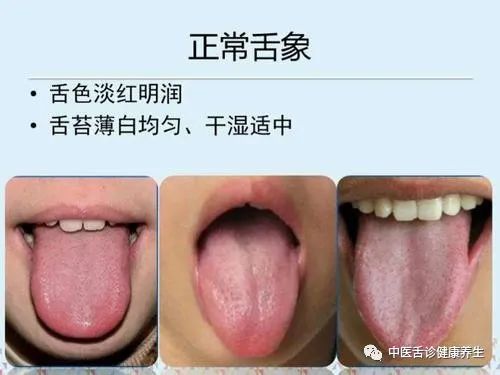
1. Individuals with teeth marks on their tongues often have Qi deficiency.
Those with Qi deficiency tend to have a lot of dampness that has not been expelled from the body, which can lead to swelling of internal organs and skin over time. However, this swelling is generally not visible, as we cannot see the swelling of internal organs, and the swelling of the skin is often not very obvious.
However, a swollen tongue, which is pressed against the teeth for 24 hours a day, will show many teeth marks when we stick it out. If the teeth marks are prominent on both sides of the tongue, it indicates Qi deficiency and a significant amount of dampness in the body.

2. A tongue coating that covers the entire tongue indicates heavy internal dampness.
Generally, a normal tongue coating should reveal the tongue body, but there is a type of coating that covers the entire tongue without exposing the tongue body, which is referred to in TCM as a “full tongue coating,” indicating that there is significant internal dampness.
The particles on the tongue cover the edges, representing heavy dampness in the body. The formation of dampness in the body is also related to where we sleep. If you often sleep in a damp room or live in the northern regions where your bedroom is too large, it can exacerbate internal dampness.

3. The thicker the tongue coating, the heavier the internal dampness.
In addition to a full tongue coating, the thickness of the coating can also indicate the severity of dampness in the body.
A thin coating, even if it covers the entire tongue, indicates that the internal dampness is not too severe; however, as the coating becomes thicker, it indicates that the dampness is increasing. If it becomes thick enough, the dampness can condense into a viscous substance known in TCM as “phlegm”—this refers more to the phlegm within the body, not necessarily the phlegm that is coughed up. At this point, the tongue coating will appear white and thick.
When the tongue coating is thin, it is relatively easy to eliminate dampness from the body. If the coating is very thick, it becomes more difficult to remove the dampness, so the thicker the coating, the more attention we need to pay to it.
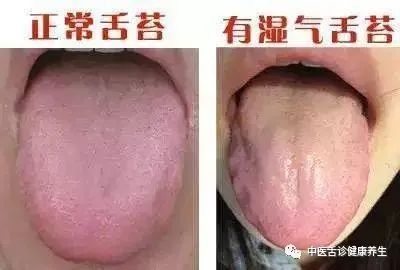
Here, I would like to remind everyone:
A red tip on the tongue may indicate gynecological issues in women or prostate problems in men.
Different parts of the tongue correspond to different organs in the body. The tip of the tongue corresponds to the heart and small intestine—TCM believes that the heart and small intestine are interrelated.
Therefore, when a person has heart fire, the tip of the tongue will be red. When we see a person’s tongue tip is red, we should first consider whether this person has heart fire or if there is something troubling them.
Additionally, the tip of the tongue may also be red during menstruation in women. This is because the tip of the tongue corresponds to the lower jiao—reproductive system—so gynecological diseases can sometimes be observed through the tip of the tongue. Women with heat in the lower jiao will have a red tip, and similarly, men with prostate issues will also have a red tip.
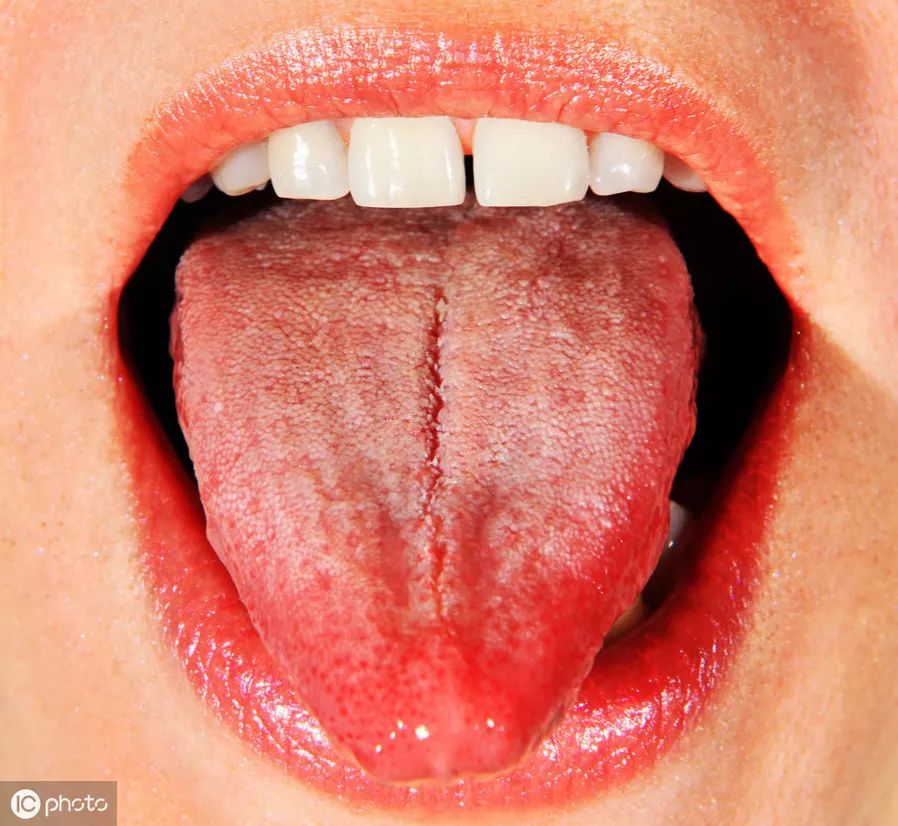
4. If the fungiform papillae on the tongue are enlarged, with red spots concentrated from the tip to the middle of the tongue, it indicates internal damp-heat.
The fungiform papillae on the tongue resemble mushrooms and contain capillaries. Normally, the fungiform papillae on the tongue should appear slightly red and not be too large. If the fungiform papillae are enlarged and there are red spots from the tip to the middle of the tongue, it indicates internal damp-heat.
At this time, a small formula can be used:
Formula: 3 grams of Dan Zhu Ye (Lophatherum gracile), 3 grams of Deng Xin Cao (Junci Medulla).
Method: Steep in water and drink as tea, one dose per day for three to five days until the red spots on the tip of the tongue fade.
Note: If you see these red spots on a child’s tongue, it indicates severe heat in the upper jiao, and the adjustment should focus on clearing heat rather than nourishing yin.
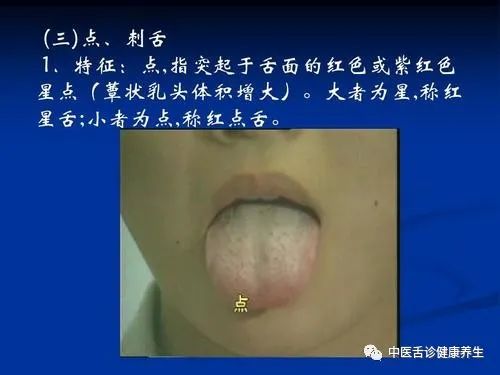
5. A swollen tongue with teeth marks and two saliva lines indicates heavy internal dampness.
If the tongue is round, slightly swollen, and has teeth marks, it often shows two saliva lines when extended, indicating heavy internal dampness.
A round tongue with saliva lines is often a sign of liver Qi stagnation leading to heavy internal dampness.
This tongue sign often reflects Qi stagnation due to liver Qi stagnation—meaning the liver Qi cannot circulate properly in the body, leading to Qi stagnation, which traps the spleen. Coupled with insufficient spleen Qi, this results in abnormal water metabolism, causing excessive dampness in the body. Individuals with this constitution often feel uncomfortable, fatigued, sweat excessively, and sweat is sticky. They may sweat profusely in the upper body while the lower body remains dry, as the middle jiao—spleen and stomach Qi is blocked, leading to phlegm-dampness accumulation, which results in this tongue sign.
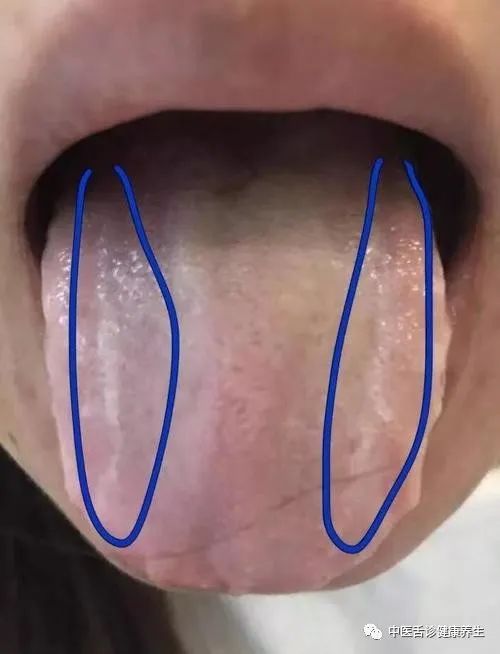
6. If the tongue coating is floating and can be scraped off, it indicates that internal dampness is not severe.
If the tongue appears swollen and has prominent teeth marks, it indicates some edema. A greasy and uneven tongue coating suggests that the coating is floating. TCM refers to this state of the tongue coating as “floating” or “superficial” because it lacks a root, and the coating appears as if it could be scraped off. This tongue sign is usually temporary. For example, consuming certain foods or drinking milk can cause this condition, and for children, temporary food accumulation can also lead to this.
Therefore, if a person already has insufficient righteous Qi and overeats in a short period, this tongue sign may temporarily appear. This rootless dampness can be eliminated with some medicine, and such a tongue sign can disappear in a day. For instance, eating a light diet, consuming coarse grains, eating vegetables, and drinking some radish soup can help eliminate this floating tongue coating and restore the function of the spleen and stomach.

7. If there are cracks in the middle of the tongue, it indicates spleen and stomach Qi deficiency.
If the teeth marks on both sides of the tongue are not prominent, but the cracks in the middle of the tongue are very obvious, even splitting into various cracks, it indicates poor spleen and stomach function, with insufficient spleen and stomach Qi, unable to nourish the tongue coating to fill in the middle groove, resulting in noticeable cracks.
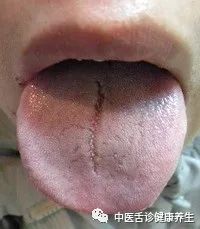
8. Individuals with Qi deficiency often have a swollen tongue.
People with Qi deficiency often have a swollen tongue (there are also cases of thin tongues, but they still have teeth marks, which is also a sign of spleen Qi deficiency). A swollen tongue indicates insufficient righteous Qi and spleen Qi deficiency.

9. No tongue coating or extremely thin coating.
If your tongue has no coating or an extremely thin coating, appearing pale, it indicates a deficiency of righteous Qi, especially insufficient spleen and stomach Qi.
Individuals with this tongue sign can be categorized into two types:
-
One type has experienced a major illness that has affected the spleen and stomach, leading to the coating retreating. Such individuals primarily need to nourish the spleen and stomach; only when the spleen and stomach are sufficient can the body recover.
2. The other type has damaged their spleen and stomach due to improper diet, which is not a major illness.
It is important to note that the tongue signs mentioned in this article do not necessarily indicate illness; if severe, they may lead to illness, but if not severe, they indicate a sub-health state. Here, I would like to remind everyone to avoid wearing makeup before seeing a TCM doctor, as it may affect the doctor’s judgment.
The doctor will not be able to accurately assess your true condition through observation. For example, if your lips appear bright red, it may actually indicate that there is some bruising or changes around the lips, suggesting issues with Qi and blood circulation.

